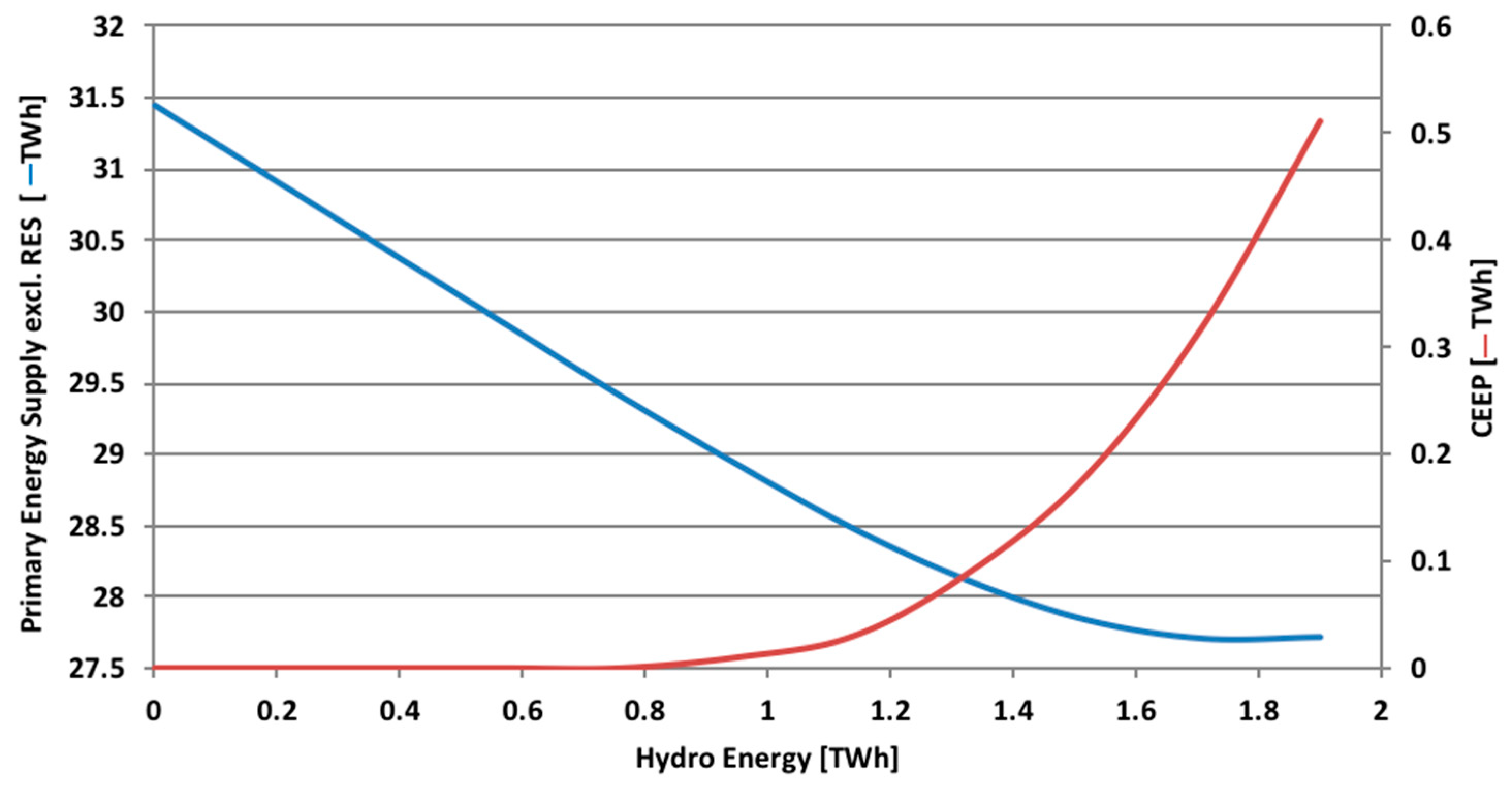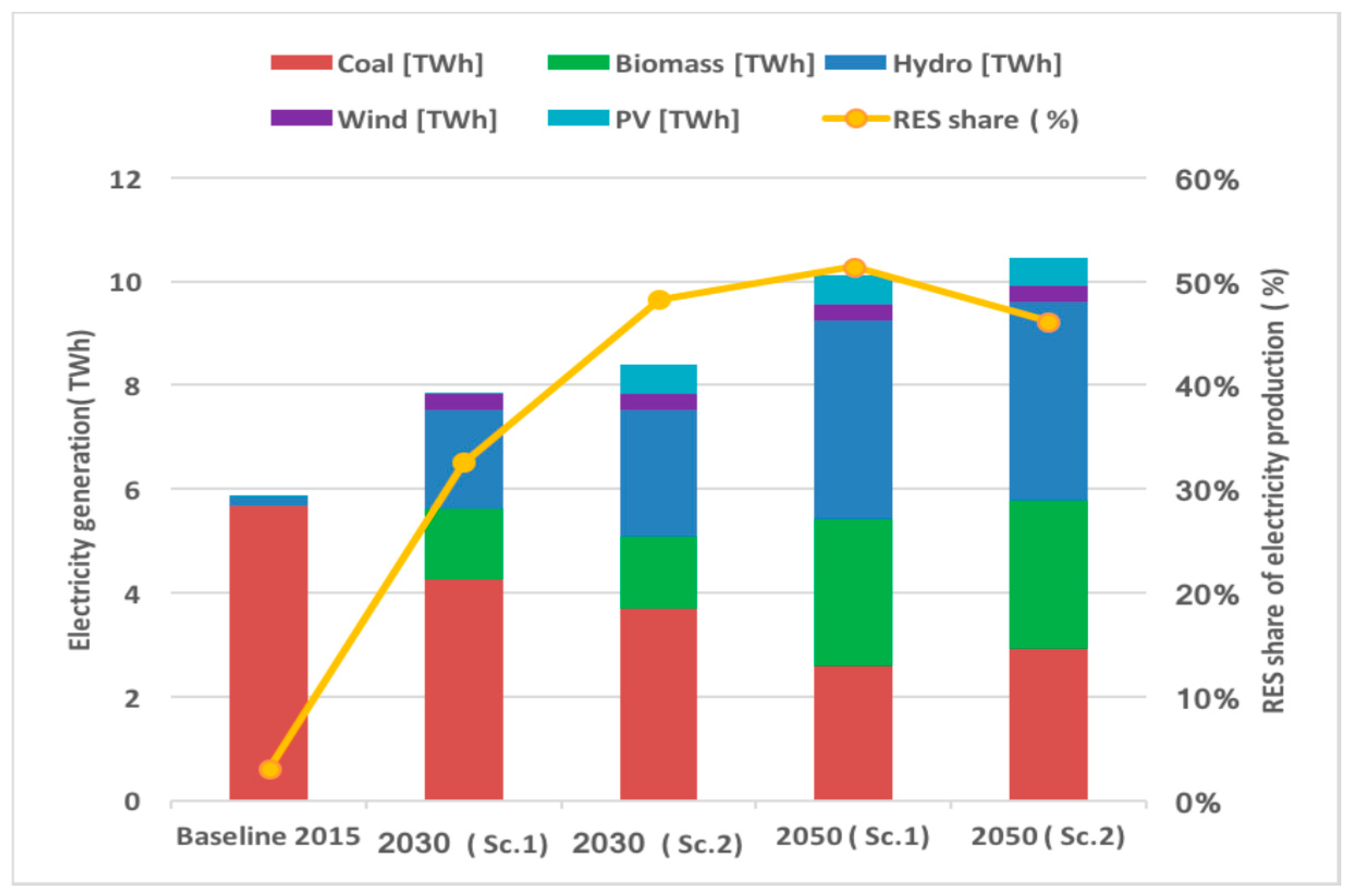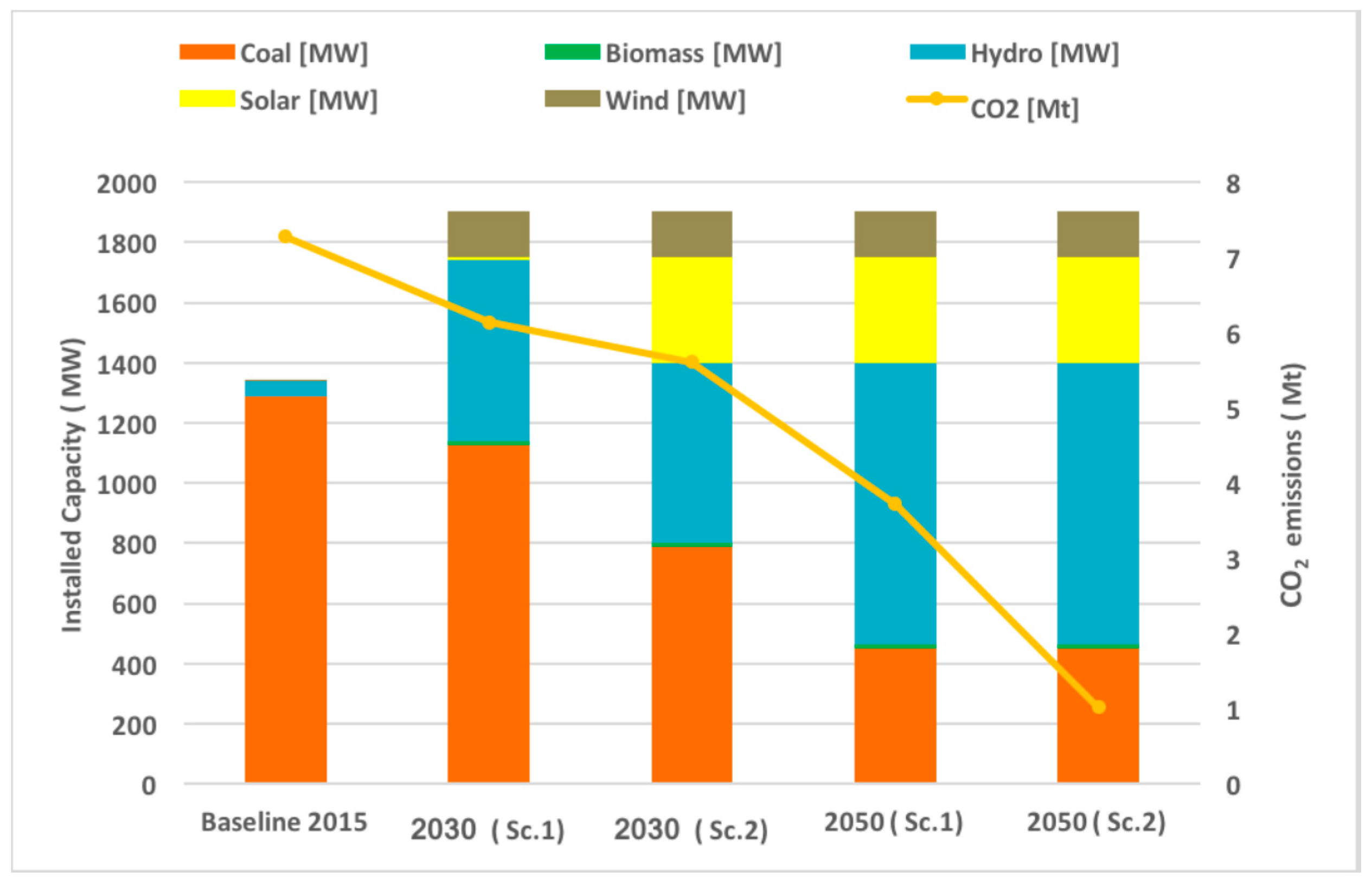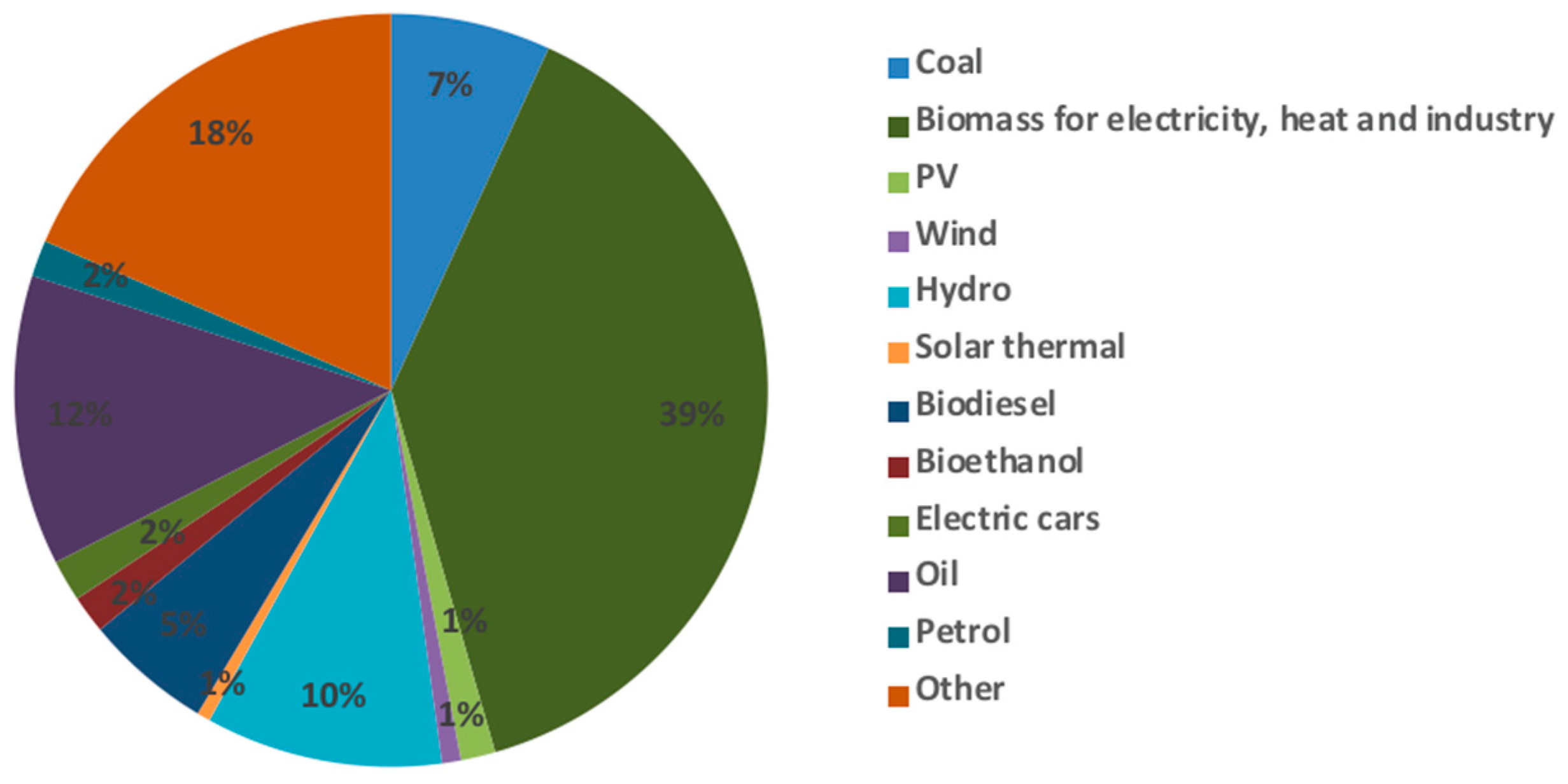Achieving a Flexible and Sustainable Energy System: The Case of Kosovo
Abstract
:1. Introduction
2. Methodology
2.1. EnergyPLAN Tool
- Balancing hourly heat demand only.
- Balancing both electricity and heat demand.
- Balancing both heat and electricity demands by reducing combined heat and power (CHP) in order to have grid stabilization.
- Balancing heat demands by using triple tariff.
2.2. Key Objectives Towards a Sustainable Energy System in Kosovo
- Operational flexibility enhancement through a comprehensive strategy for balancing electricity and supply in a secure and efficient manner.
- Cutting CO2 emissions by 50% in the year 2050.
- Reduce the coal share in the PES in both 2030 and 2050 scenarios.
2.3. Data Collection
3. Kosovo Energy System
3.1. Baseline Scenario for the Year 2015
3.2. Energy System Scenarios for 2030 and 2050
- One unit of CHP plant with 339 MW installed capacity was substituted with a hydropower plant of the same capacity.
4. Results and Discussion
4.1. Technical Analysis
4.2. Environmental Analysis
4.3. Cost Analysis
4.4. Comparative Analysis
5. Conclusions
6. Future Work
Author Contributions
Funding
Acknowledgments
Conflicts of Interest
Abbreviations
| CCS | Carbon Capture and Sequestration |
| PES | Primary Energy Supply |
| CEEP | Critical Excess Electricity Production |
| RES | Renewable Energy Share |
| KOSTT | Kosovo Transmission System and Market Operator |
| KEDS | Kosovo Electricity Distribution and Supply Company |
| ERO | Energy Regulatory Office |
| ENTSOE | European Network of Transmission System Operators for Electricity |
| EU | European Union |
| CHP | Combined heat and power |
| SEE | South East Europe (The SEE region consists of Albania, Bosnia and Herzegovina, Bulgaria, Croatia, Greece, Macedonia, Montenegro, Romania, Serbia, Slovenia and Kosovo) |
| H2RES | Energy planning software for optimization of microgrid components sizing |
References
- Nations, U. Annual assessment of progress towards the sustainable development goals. In The Sustainable Development Goals Report 2016; Department of Economic and Social Affairs of the United Nations, United Nations Publications: New York, NY, USA, 2016. [Google Scholar]
- Kittner, N.; Dimco, H.; Azemi, V.; Tairyan, E.; Kammen, D.M. Sustainable Energy Pathways for Kosovo; Technical report. Kosovo Civil Society Consortium for Sustainable Development, 2014. Available online: https://www.kosid.org/file/repository/Sustainable_Energy_for_Kosovo_Energy_Policy_kosid.pdf (accessed on 26 August 2019).
- International Energy Agency. CO2 Emissions from Fuel Combustion Highlights; Technical Report; International Energy Agency, Office of Management and Administration International Energy Agency: Paris, France, 2016. [Google Scholar]
- Ministry of Economic Development, Republic of Kosovo. Annual Energy Balance of Republic of Kosovo for the Year 2016; Annual Report; Ministry of Economic Development, Republic of Kosovo, Ministry of Economic Development: Pristina, Kosovo, 2015. [Google Scholar]
- House of Lords, European Union Committee. The EU’s Target for Renewable Energy: 20% By 2020; Technical Report; House of Lords, European Union Committee: London, UK, 2012. [Google Scholar]
- National Renewable Energy Action Plan (NREAP) 2011–2020; Technical Report; Ministry of Economic Development: Pristina, Republic of Kosovo, 2013.
- European Commission. A Policy Framework for Climate and Energy in the Period from 2020 to 2030; Technical Report; European Commission: Brussels, Belgium, 2014. [Google Scholar]
- Dincer, I. Renewable energy and sustainable development: A crucial review. Renew. Sustain. Energy Rev. 2000, 4, 157–175. [Google Scholar] [CrossRef]
- Buran, B.; Butler, L.; Currano, A.; Smith, E.; Tung, W.; Cleveland, K.; Buxton, C.; Lam, D.; Obler, T.; Rais-Bahrami, S.; et al. Environmental benefits of implementing alternative energy technologies in developing countries. Appl. Energy 2003, 76, 89–100. [Google Scholar] [CrossRef]
- Leaman, C. The benefits of solar energy. Renew. Energy Focus 2015, 16, 113–115. [Google Scholar] [CrossRef]
- Mohtasham, J. Review Article-Renewable Energies. Energy Procedia 2015, 74, 1289–1297. [Google Scholar] [CrossRef] [Green Version]
- Kabashi, S.; Bekteshi, S.; Ahmetaj, S.; Kabashi, G.; Najdovski, D.; Zidanaiek, A.; Alaus, I. Effects of Kosovo’s energy use scenarios and associated gas emissions on its climate change and sustainable development. Appl. Energy 2011, 88, 473–478. [Google Scholar] [CrossRef]
- Jebaraj, S.; Iniyan, S. A review of energy models. Renew. Sustain. Energy Rev. 2006, 10, 281–311. [Google Scholar] [CrossRef]
- Jebaselvi, G.A.; Paramasivam, S. Analysis on renewable energy systems. Renew. Sustain. Energy Rev. 2013, 28, 625–634. [Google Scholar] [CrossRef]
- Yu, L.; Li, Y.P.; Huang, G.H.; Fan, Y.R.; Yin, S. Planning regional-scale electric power systems under uncertainty: A case study of Jing-Jin-Ji region, China. Appl. Energy 2017. [Google Scholar] [CrossRef]
- Du, W.J.; Chen, X.; Wang, H.F. PLL Performance Evaluation Considering Power System Dynamics for Grid Connection of Renewable Power Generation. J. Environ. Inf. 2018, 32, 55–62. [Google Scholar] [CrossRef] [Green Version]
- Li, W.; Bao, Z.; Huang, G.H.; Xie, Y.L. An Inexact Credibility Chance-Constrained Integer Programming for Greenhouse Gas Mitigation Management in Regional Electric Power System under Uncertainty. J. Environ. Inf. 2017, 35, 111–122. [Google Scholar] [CrossRef]
- Nie, S.; Huang, Z.C.; Huang, G.H.; Yu, L.; Liu, J. Optimization of electric power systems with cost minimization and environmental-impact mitigation under multiple uncertainties. Appl. Energy 2018, 221, 249–267. [Google Scholar] [CrossRef]
- Cosic, B.; Krajacic, G.; Markovska, N.; Bjelić, I.B.; Rajaković, N.; Duić, N. 100% Renewable Energy Solutions for Regions: the Case of South East Europe. In Proceedings of the XXIX medjunarodno savjetovanje ENERGETIKA, Zlatibor, Serbia, 26–29 March 2013. [Google Scholar]
- Cosic, B.; Krajacic, G.; Duic, N. A 100% renewable energy system in the year 2050: The case of Macedonia. Energy 2012, 48, 80–87. [Google Scholar] [CrossRef] [Green Version]
- Lund, H.; Mathiesen, B. Energy system analysis of 100% renewable energy systems—The case of Denmark in years 2030 and 2050. Energy 2009, 34, 524–531. [Google Scholar] [CrossRef]
- Krajacic, G.; Duic, N.; da Graca Carvalho, M. How to achieve a 100% RES electricity supply for Portugal? Appl. Energy 2011, 88, 508–517. [Google Scholar] [CrossRef]
- Safian, F. Modelling the Hungarian energy system-The first step towards sustainable energy planning. Energy 2014, 69, 58–66. [Google Scholar] [CrossRef]
- Connolly, D.; Lund, H.; Mathiesen, B.; Leahy, M. Modelling the existing Irish energy-system to identify future energy costs and the maximum wind penetration feasible. Energy 2010, 35, 2164–2173. [Google Scholar] [CrossRef]
- Krajacic, G.; Duic, N.; Zmijarevic, Z.; Mathiesen, B.V.; Vucinic, A.A.; da Graca Carvalho, M. Planning for a 100% independent energy system based on smart energy storage for integration of renewables and CO2 emissions reduction. Appl. Therm. Eng. 2011, 31, 2073–2083. [Google Scholar] [CrossRef] [Green Version]
- Elliston, B.; Diesendorf, M.; MacGill, I. Simulations of scenarios with 100% renewable electricity in the Australian National Electricity Market. Energy Policy 2012, 45, 606–613. [Google Scholar] [CrossRef]
- Suri, M.; Huld, T.A.; Dunlop, E.D.; Ossenbrink, H.A. Potential of solar electricity generation in the European Union member states and candidate countries. Sol. Energy 2007, 81, 1295–1305. [Google Scholar] [CrossRef]
- McFarland, J.R.; Herzog, H.J. Incorporating carbon capture and storage technologies in integrated assessment models. Energy Econ. 2006, 28, 632–652. [Google Scholar] [CrossRef] [Green Version]
- Siefert, N.S.; Chang, B.Y.; Litster, S. Exergy and economic analysis a CaO-looping gasifier for IGFC-CCS and IGCC-CCS. Appl. Energy 2014, 128, 230–245. [Google Scholar] [CrossRef]
- Olateju, B.; Kumar, A. Techno-economic assessment of hydrogen production from underground coal gasification (UCG) in Western Canada with carbon capture and sequestration (CCS) for upgrading bitumen from oil sands. Appl. Energy 2013, 111, 428–440. [Google Scholar] [CrossRef]
- Zhou, W.; Zhu, B.; Fuss, S.; Szolgayovai, J.; Obersteiner, M.; Fei, W. Uncertainty modeling of CCS investment strategy in China’s power sector. Appl. Energy 2010, 87, 2392–2400. [Google Scholar] [CrossRef]
- Zhu, L.; Fan, Y. A real options-based CCS investment evaluation model: Case study of China’s power generation sector. Appl. Energy 2011, 88, 4320–4333. [Google Scholar] [CrossRef]
- Li, M.; Rao, A.D.; Samuelsen, G.S. Performance and costs of advanced sustainable central power plants with CCS and H2 co-production. Appl. Energy 2012, 91, 43–50. [Google Scholar] [CrossRef] [Green Version]
- Viebahn, P.; Daniel, V.; Samuel, H. Integrated assessment of carbon capture and storage (CCS) in the German power sector and comparison with the deployment of renewable energies. Appl. Energy 2012, 97, 238–248. [Google Scholar] [CrossRef] [Green Version]
- Pettinau, A.; Ferrara, F.; Amorino, C. Techno-economic comparison between different technologies for a CCS power generation plant integrated with a sub-bituminous coal mine in Italy. Appl. Energy 2012, 99, 32–39. [Google Scholar] [CrossRef]
- Duan, H.B.; Fan, Y.; Zhu, L. What’s the most cost-effective policy of CO2 targeted reduction: An application of aggregated economic technological model with CCS? Appl. Energy 2013, 112, 866–875. [Google Scholar] [CrossRef]
- Li, H.; Yan, J. Impacts of equations of state (EOS) and impurities on the volume calculation of CO2 mixtures in the applications of CO2 capture and storage (CCS) processes. Appl. Energy 2009, 86, 2760–2770. [Google Scholar] [CrossRef]
- Liang, X.; Reiner, D.; Li, J. Perceptions of opinion leaders towards CCS demonstration projects in China. Appl. Energy 2011, 88, 1873–1885. [Google Scholar] [CrossRef]
- Arnette, A.N. Renewable energy and carbon capture and sequestration for a reduced carbon energy plan: An optimization model. Renew. Sustain. Energy Rev. 2017, 70, 254–265. [Google Scholar] [CrossRef]
- Leung, D.Y.; Caramanna, G.; Maroto-Valer, M.M. An overview of current status of carbon dioxide capture and storage technologies. Renew. Sustain. Energy Rev. 2014, 39, 426–443. [Google Scholar] [CrossRef] [Green Version]
- Assessment of CO2 Storage Potential in Europe. Available online: https://ec.europa.eu/energy/sites/ener/files/documents/56-2014%20Final%20report.pdf (accessed on 21 May 2019).
- Voll, D.; Wauschkuhn, A.; Hartel, R.; Genoese, M.; Fichtner, W. Cost Estimation of Fossil Power Plants with Carbon Dioxide Capture and Storage. Energy Procedia 2012, 23, 333–342. [Google Scholar] [CrossRef] [Green Version]
- Kozlova, M.; Yeomans, J.S. Multi-Variable Simulation Decomposition in Environmental Planning: An Application to Carbon Capture and Storage. J. Environ. Inf. Lett. 2019, 1, 20–26. [Google Scholar] [CrossRef] [Green Version]
- Republic of Kosovo, Ministry of Foreign Affairs. Mining and Energy in Kosovo. Available online: http://www.mfa-ks.net/?page=2,197,2266, 2015 (accessed on 11 March 2018).
- Connolly, D.; Lund, H.; Mathiesen, B.; Leahy, M. A review of computer tools for analysing the integration of renewable energy into various energy systems. Appl. Energy 2010, 87, 1059–1082. [Google Scholar] [CrossRef]
- Lund, H. EnergyPLAN Advanced Energy Systems Analysis Computer Model; Documentation Version 12; Sustainable Energy Planning Research Group, Aalborg University: Aalborg, Denmark, 2015. [Google Scholar]
- Porubova, J.; Bazbauers, G. Analysis of long-term plan for energy supply system for Latvia that is 100% based on the use of local energy resources. Sci. J. Riga Tech. Univ. Environ. Clim. Technol. 2010, 4, 82–90. [Google Scholar] [CrossRef] [Green Version]
- Child, M.; Nordling, A.; Breyer, C. The impacts of high V2G participation in a 100% renewable Åland energy system. Energies 2018, 11, 2206. [Google Scholar] [CrossRef] [Green Version]
- Reuters. Kosovo, ContourGlobal Sign Deal to Build 500 MW Coal-Fired Power Plant. Available online: https://uk.reuters.com/article/kosovo-energy/kosovo-contourglobal-sign-deal-to-build-500-mw-coalfired-power-plant-idUKL8N1OK2SI, 2018 (accessed on 11 March 2018).
- Kittner, N.; Fadadu, R.P.; Buckley, H.L.; Schwarzman, M.R.; Kammen, D.M. Trace Metal Content of Coal Exacerbates Air-Pollution-Related Health Risks: The Case of Lignite Coal in Kosovo. Environ. Sci. Technol. 2018, 52, 2359–2367. [Google Scholar] [CrossRef] [Green Version]
- Draft Energy Strategy of Republic of Kosovo 2016–2025 Report; Ministry of Economic Development, Republic of Kosovo, Ministry of Economic Development: Pristina, Kosovo, 2016.
- Kosovo Transmission System and Market Operator. Available online: https://kostt.com/ (accessed on 1 November 2016).
- Kosovo Electricity Distribution and Supply Company. Available online: https://www.keds-energy.com/en/about.asp (accessed on 1 November 2016).
- EnergyPLAN: Advanced energy system analysis computer tool, A.U.E. Available online: http://www.energyplan.eu. (accessed on 1 November 2018).
- Kosovo Energy Regulatory Office. Annual Report 2015; Kosovo Energy Regulatory Office: Pristina, Kosovo, 2015. [Google Scholar]
- Projected Costs of Generating Electricity, Executive Summary; Technical Report; International Energy Agency: Paris, France, 2015; Available online: https://www.oecd-nea.org/ndd/pubs/2015/7279-proj-costs-electricity-2015-es.pdf (accessed on 31 October 2018).
- Paul, L.; Giorgio Simbolotti, G.T. ETSAP Energy Technology Systems Analysis Programme; Technical Report; IEA Energy Technology: Network, NY, USA, 2010. [Google Scholar]
- International Energy Agency. Next Generation Wind and Solar Power, From Cost to Value; Clean Energy Ministerial, Accelerating Global Clean Energy Transition, International Energy Agency, 9 rue de la Federation: Paris, France, 2016. [Google Scholar]
- International Energy Agency. Technology Roadmap, Wind Energy; Technical Report; International Energy Agency, IEA Publications, 9 rue de la Federation: Paris, France, 2010. [Google Scholar]
- Mathew, S. Wind Energy Fundamentals, Resource Analysis and Economics; Springer: Berlin/Heidelberg, Germany; New York, NY, USA, 2006. [Google Scholar]
- World Energy Council. World Energy Perspective Cost of Energy Technologies; Technical Report 4184478; World Energy Council, World Energy Council, Regency House: London, UK, 2013. [Google Scholar]
- National Renewable Energy Laboratory. Distributed Generation Renewable Energy Estimate of Costs; Technical Report; National Renewable Energy Laboratory: Denver, CO, USA, 2016. [Google Scholar]
- International Renewable Energy Agency. Renewable Energy Technologies: Cost Analysis Series, Hydropower; Technical Report; International Renewable Energy Agency: Abu Dhabi, UAE, 2012. [Google Scholar]
- Connolly, D. Finding and Inputting Data into Energy PLAN Version 5; Documentation Version 5; Aalborg University: Aalborg, Denmark, 2015. [Google Scholar]
- International Energy Agency. Renewable Energy Essentials: Hydropower; Technical Report. International Energy Agency, 2010. Available online: https://webstore.iea.org/renewable-energy-essentials-hydropower (accessed on 18 March 2019).
- Energi Styrelsen. Technology Data for Energy Plants, Generation of Electricity and District Heating, Energy Storage and Energy Carrier Generation and Conversion; Technical Report; Energi Styrelsen: Esbjerg, Denmark, 2012. [Google Scholar]
- Komoni, V.; Gebremedhin, A.; Ibrahimi, N. A comparison of the performance of mono-Si and poly-Si photovoltaic modules operating under Kosovo climate condition. J. Renew. Sustain. Energy 2018. [Google Scholar] [CrossRef] [Green Version]
- Ekkehart Naumann, M.P. Identification of Potential for Application of Solar Energy Technology in the Municipality of Dragash; Technical Report. United Nations Development Programme, 2012. Available online: https://www.undp.org/content/dam/kosovo/docs/dragash/Identifiaction%20of%20potential%20for%20renewable%20solar%20energy%20application%20in%20the%20Municiaplity%20of%20Dragash_02042012-Eng.pdf (accessed on 21 November 2018).
- Kosovo Transmission System and Market Operator, Long-term Planning Department. List of New Transmission Capacities and Interconnection Lines (2011–2020); Technical Report; Kosovo Transmission System and Market Operator: Pristina, Kosovo, 2010. [Google Scholar]











| Scenario | Software | Installed Generation Capacity (MW) | PES (PJ) | Total elec. gen (TWh/year) | Elec. Demand (TWh/year) | RES (%) | CO2 Emissions (Mt/year) | Ref. | |||||
|---|---|---|---|---|---|---|---|---|---|---|---|---|---|
| Thermal | Hydro | Biomass | Wind | Heat pumps | PV | ||||||||
| Ref. (2008) | EnergyPLAN | 41,431 | 23,125 | 696 | 1149 | 10 | 5312 | 277.4 | 360 | [19] | |||
| Alt. (2020) | 51,555 | 34,312 | 2539 | 17,474 | 3834 | 6000 | 350 | 21 | 370 | ||||
| Alt. (2030) | 42,612 | 3132 | 34,000 | 500 | 16,000 | 5190 | 410 | 50 | 200 | ||||
| Alt. (2050) | 150,000 | 4000 | 100,530 | 600 | 60,000 | 3397 | 520 | 100 | 10 | ||||
| Ref. (2008) | EnergyPLAN | 300 | 100 | 120 | 9 | 7.68 | 9 | [20] | |||||
| Alt. (2030) | 1375 | 800 | 1500 | 1100 | 105 | 12 | 12.37 | 50 | 4 | ||||
| Alt. (2050) | 2760 | 50 | 1600 | 80 | 15 | 100 | 0 | ||||||
| Ref. (2004) | EnergyPLAN | 3000 | 850 | [21] | |||||||||
| Alt. (2030) | 6000 | 450 | 700 | 970 | 33.22 | 50 | 54 | ||||||
| Alt. (2050) | 1500 | 420 | 30.2 | 100 | 0 | ||||||||
| Ref. (2006) | H2RES | 5851 | 4965 | 477.2 | 1600 | 3.4 | 49 | 49.176 | 32.9 | [22] | |||
| Alt. (2020) | 7000 | 8500 | 1500 | 54 | 81 | ||||||||
| Alt. | 3454 | 750 | 9970 | 4500 | 100 | ||||||||
| Ref. (2007) | EnergyPLAN | 2139 | 508 | 724 | 655.4 | 27.19 | 28.5 | 46.8 | [24] | ||||
| Alt. (2020) | 20 | ||||||||||||
| Ref. (2008) | EnergyPLAN, H2RES | 22.14 | [25] | ||||||||||
| Alt. (2020) | 2400 | 300 | 85 | 1200 | 386.84 | 106.78 | 20 | 21.34 | |||||
| Alt. (2020) | 200 | 172 | 100 | ||||||||||
| Fuel Type | Household | Service | Industry | Transport | Agriculture | Total | Ref. |
|---|---|---|---|---|---|---|---|
| Biomass | 2.72 | 0.08 | 0.14 | 0.006 | 2.95 | [4] | |
| Oil | 0.23 | 0.48 | 1.83 | 3.41 | 0.16 | 6.12 | [4] |
| Coal | 0.16 | 0.31 | 0.21 | 0.007 | 0.63 | [4] | |
| Electricity-applicants | 2.9 | 0.82 | 1.22 | 0.02 | 4.96 | [4] |
| Technology | Investment (MEuro/MW) | Fixed O&M (% of Inv.) | Lifetime (years) | Ref. |
|---|---|---|---|---|
| Electricity | ||||
| CHP | 1.4 | 2.5 | 25 | [56,57] |
| Onshore wind power | 1.9 | 1.5 | 20 | [58,59,60] |
| PV | 1.9 | 1 | 33 | [61,62] |
| River of hydro | 2 | 2.5 | 50 | [63,64] |
| Heating | ||||
| Ind. Bio-heat boiler | 0.68 | 1 | 20 | [65] |
| Electric heating | 0.8 | 1 | 30 | [66] |
| Solar thermal | 4.5 | 0.5 | 30 | [66] |
| Ind. Heat pumps | 0.9 | 1.5 | 20 | [65] |
| Transport | ||||
| Biodiesel plant | 1.89 | 3.01 | 20 | [25] |
| Biopetrol plant | 0.44 | 7.68 | 20 | [25] |
| Moth | KOSTT | EnergyPLAN | Difference |
|---|---|---|---|
| Jan | 814 | 814 | 0 |
| Feb | 768 | 766 | 2 |
| Mar | 727 | 727 | 0 |
| Apr | 651 | 644 | 7 |
| May | 525 | 525 | 0 |
| Jun | 518 | 518 | 0 |
| Jul | 545 | 547 | −2 |
| Aug | 544 | 544 | 0 |
| Sep | 543 | 545 | −2 |
| Oct | 614 | 616 | −2 |
| Nov | 687 | 689 | −2 |
| Dec | 821 | 819 | 2 |
| Sector | Scenario 1 for 2030 | Scenario 1 for 2050 |
|---|---|---|
| Electricity | Increase in solar PV from 0.102 MW to 10.102 MW | Introduce 339 MW hydropower |
| Increase in wind power from 1.35 MW to 151.35 MW | Introduce 339 MW PV | |
| Increase in hydropower from 52.98 MW to 597.87 MW | Introduce 14 MW of biomass CHP for electricity | |
| Construction of new CHP with 450 MW installed capacity based on coal and biomass | Decommission of condensing power plant Kosova B | |
| Technical minimum of total CHP plants to be equal to 580 MW | ||
| Heating | Replacement of coal boilers with cogeneration and heat pumps | 80% of heat demand to be covered by renewable sources |
| 20% of total heat demand to be covered by cogeneration from CHP | Supply 72.32% of heat demand with biomass micro CHP Supply 3.84% of heat demand with solar thermal and heat pumps | |
| 50% of heat demand to be covered by renewable sources | Heating will count 2.39% of total heat demand | |
| Electric heating will remain the same accounting 5.98% of total heat demand | 9.61% of heat demand will be covered by biomass boilers | |
| Solid biomass will count with 47.6% | Supply 8% of heat demand by cogeneration | |
| Supply 45.2% of heat demand by biomass micro CHP | ||
| Supply 10% of heat demand by cogeneration | ||
| Supply 2.5% of heat demand by individual heat pumps | ||
| Transport | Replacement of 20% of fuels (petrol, diesel, LPG and jet fuel) in transport with biofuels (bioethanol and biodiesel) | 50% of transport demand to be based on renewable sources (bioethanol and biodiesel) |
| Introducing electric cars in transportation with 5% in the overall fuel consumption | Increase the share of electric cars for 5% share from 2030 scenario in transport sector |
© 2019 by the authors. Licensee MDPI, Basel, Switzerland. This article is an open access article distributed under the terms and conditions of the Creative Commons Attribution (CC BY) license (http://creativecommons.org/licenses/by/4.0/).
Share and Cite
Ibrahimi, N.; Gebremedhin, A.; Sahiti, A. Achieving a Flexible and Sustainable Energy System: The Case of Kosovo. Energies 2019, 12, 4753. https://doi.org/10.3390/en12244753
Ibrahimi N, Gebremedhin A, Sahiti A. Achieving a Flexible and Sustainable Energy System: The Case of Kosovo. Energies. 2019; 12(24):4753. https://doi.org/10.3390/en12244753
Chicago/Turabian StyleIbrahimi, Njomza, Alemayehu Gebremedhin, and Alketa Sahiti. 2019. "Achieving a Flexible and Sustainable Energy System: The Case of Kosovo" Energies 12, no. 24: 4753. https://doi.org/10.3390/en12244753





